Welcome back!
You're currently shopping with your default address:

The Vinaforé Collection is a curation of distinctively classic wines from around the globe. Each is selected to capture the truest expression of the regions in which they're grown, making every bottle an invitation to explore the world of wine.
Whether looking for a red wine with a full mouthfeel and savory fruit-forward flavors or a crisp and refreshing white wine, Vinaforé has something for everyone. Each varietal is selected to capture the truest expression of the regions in which they are grown, making every bottle an invitation to explore the world of wine.
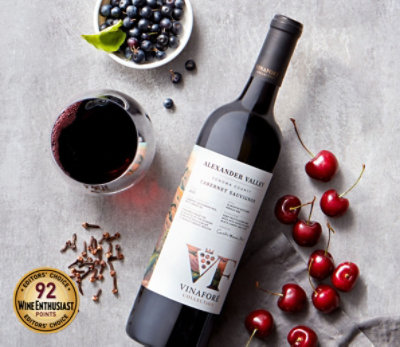
Elegant European style with the power of California fruit. Notes of cassis and black cherry aromas are followed with clove and spice flavors. The lush and lingering mouthfeel is followed with fine grain tannins and a lengthy finish.
The Alexander Valley is located in northern Sonoma County along the Russian River. The soils are deep alluvial in nature with veins of gravel and rock throughout. The climate is warm but frequently will experience cool, foggy nights. These swings in temperature create grapes with bright character and balance. Cabernet Sauvignon is the dominate variety in the Alexander Valley but is joined by Zinfandel, Sauvignon Blanc, Chardonnay, and other lesser varietals. Cabernet Sauvignon harvest in the Alexander Valley usually starts in early October and runs well into the month.
Vinaforé® Alexander Valley Cabernet Sauvignon is made from a single vineyard source in the heart of the Alexander Valley sub-appellation of Sonoma County. The blend consists of 94% Cabernet Sauvignon and 6% Petit Verdot. The Petit Verdot is utilized as a classical Bordeaux varietal to create depth and posture to the Cabernet Sauvignon.
The two varietals were fermented separately to maintain varietal integrity. Upon harvest, the grapes were crushed to a stainless-steel tank and cold soaked for 48 hours prior to starting the fermentation. Vigorous pump-overs occurred during this winemaking phase to allow for maximum color and flavor components and minimal tannin extraction. The fermentation lasted for 12 days never exceeding 80 degrees temperature with minimal pump-overs to create a more elegant structure. Upon completion of fermentation, the resulting free run wine was drained from the skins, and the must was pressed separating out any hard press to avoid harsh tannins and bitterness. Once malolactic fermentation was completed the wines were blended and aged with a combination of 65% new tight grained French oak and 35% neutral oak for 16 months.
Steak au poivre, braised escarole or hard cheeses.
Fruit forward aromas of Bing cherries and violets with a hint of oak spice followed by a rich flavor of cherry pie and a rich mouthfeel. The finish is long and smooth with enough lift to create an elegant impression.
The Sonoma Coast viticultural area produces some of the most sought-after Burgundian varieties, like Pinot Noir. The growing area is known for its cooling winds with foggy nights and moderately warm days. The soils within the growing region vary from clay loam to rocky/gravelly soils related to the Russian River. Due to the cooler climate, the Pinot Noir grapes receive extended ripening, developing distinct aromas and flavors. Harvest in the Sonoma Coast area usually begins in mid-September and continues through the middle of October.
Vinaforé® Sonoma Coast Pinot Noir is made from 100% Pinot Noir and is a blend of two different vineyards from 777 and 828 clones. The 777-clone vineyard located in the southern Los Carneros sub-appellation creates wine with a distinctive violet aroma and lifted acidity. The 828-clone vineyard is located in the Russian River sub-appellation that brings bright cherry fruit and velvety textures. Each vineyard lot was fermented separately to allow the individual components to develop.
After the grapes were crushed to tank with 30% whole berries, they were held at 50 degrees and allowed to cold soak for a total of 72 hours. This process allows for gentle extraction of the flavors and aromas from the grape skins.
After cold soaking, fermentation was initiated and took place at very cool temperatures for a period of 16 days. The fermenting juice was pumped over the skins twice a day for eight days and once per day for eight days to minimize extraction of harsh bitterness and tannin. Once fermentation was complete, the resulting wine was pressed off of the grape skins while separating the free run juice from the hard press.
The wine completed malolactic fermentation and aged with 40% new Burgundy French Oak for a duration of six months. The judicious oaking process helps to bring spice to the aroma and flavors while maintaining the clonal fingerprints.
Duck confit, coq au vin or salmon.
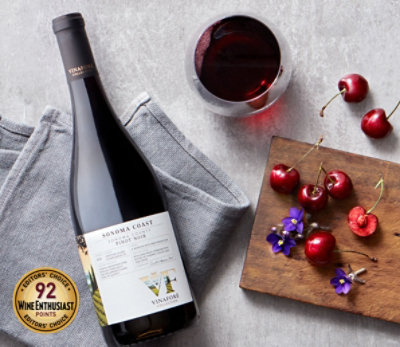

Fruit clean aromas and flavors of grapefruit, gooseberry, and lemon zest with a bright and refreshing acidity.
Sonoma County is home to many plantings of Sauvignon Blanc across the growing region. The varietal is tolerant of the heat in some of the growing areas but also shows different flavor and aroma elements when grown in the cooler regions, such as the Russian River Valley or Carneros. The vineyards encompass many soil types and climatic conditions, each of which produce unique elements in the wine. Sauvignon Blanc harvest usually begins in late August and continues through mid to late September.
Vinaforé® Sonoma County Sauvignon Blanc is 100% Sauvignon Blanc from two different vineyards within the Sonoma County Appellation. One vineyard is located in the cooler Los Carneros sub-appellation in the southern end of Sonoma County near the San Pablo Bay. This site produces grapes with bright and refreshing acidity and vibrant fruit. The other vineyard is located in the warmer Dry Creek Valley sub-appellation in Northern Sonoma County that produces grapes with riper fruit flavors and richer mouthfeel.
After pressing, the juice was fermented in stainless steel tanks at very cold temperatures to preserve the grape characteristics. Fermentation lasted for 28 days. No oak was used to age the wine and once the wines completed fermentation, they were immediately racked off of any remaining solids. The wines did not go through malolactic secondary fermentation. The wines were blended, filtered and bottled early to retain the varietal freshness.
Oysters au gratin, warm chèvre salad or jambalaya.
2020 Vinaforé® Côtes du Rhône Villages – 90 Points James Suckling
"Aromas of cooked cherries, dark strawberries, dried herbs and potpourri. A medium-bodied red with fine-grained tannins. Spicy, with plenty of dark cherries and herbs on the palate and a fruity finish. 50% grenache, 35% syrah and 15% mourvedre. Drink now."
Savory raspberry and blackberry bramble notes are accented by Mediterranean herbs and cracked pepper. Fine tannins with a full body.
Like the wines themselves, the Rhône valley is a blend of many climatic, soil and varietal influences. The synergy between these factors has led to not only the international prominence of the Rhône’s wines, but also as the culinary heart of France. The wines of Côtes du Rhône have seen prominence for hundreds of years with King Louis XV in 1737 requiring “CDR” to be branded onto barrels to prevent counterfeit. Côtes du Rhône Villages comes from more selective vineyard sites and have more stringent quality methods than base Côtes du Rhône. Varied soils and microclimates and a traditional blend including Grenache, Syrah and Mourvèdre create a wine greater than the sum of its parts.
Vinaforé® Côtes du Rhône Villages is an assemblage of 3 different terroirs. The base of the wine 65% comes from Chateauneuf de Gadagne (south Vaucluse), 15% comes from Jonquières (center Vaucluse), and 20% comes from Roaix (north Vaucluse). The average fermentation/maceration time was two weeks with 85% destemmed. The blend consists of 50% Grenache, 35% Syrah, and 15% Mourvèdre. This wine was aged in traditional neutral tank and foudre which allow for the integration of the three varietals.
From France’s venerated Rhône valley, this classic blend of Grenache, Syrah, and Mourvèdre (often called a GSM blend) brings all the depth and sense of place of the Old World.
Cassoulet, barbeque or aged goat cheese.
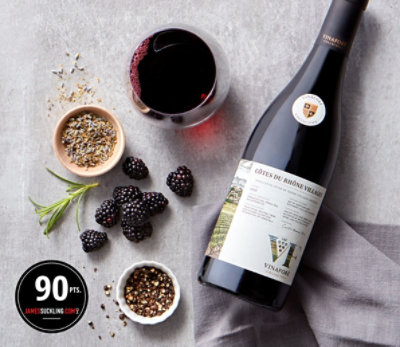
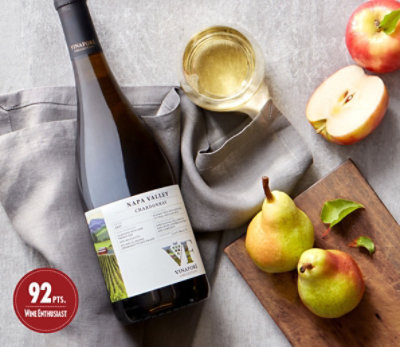
Acclaim
2021 Vinaforé® Napa Valley Chardonnay – 90 Points Wine Enthusiast
"This concentrated, moderately oaky wine offers buttery, toasty aromas, good ripe Bartlett pear and lemon flavors and a smooth texture that was enhanced with full malolactic fermentation and partial aging on the lees." –J.G.
Crisp pear and apple aromas with a rich mouthfeel ending with a buoyant and inviting finish.
California’s Napa Valley is one of the premier wine grape growing regions in the world. It is home to many varieties of wine grapes including Burgundian varietals like Chardonnay. Chardonnay is now predominately grown in the southern portion of Napa Valley where the climate is more moderate with cooler daytime temperatures and cool foggy nights. Most of the Chardonnay is grown in the deep fertile soils along the Napa River or in the Carneros growing region where the vineyards are influenced by the effects of the San Pablo Bay. The Chardonnay harvest usually begins in mid-September and wraps up in early October.
Vinaforé® Napa Valley Chardonnay is 100% Chardonnay and is a blend of three different vineyard sources from the southern part of Napa Valley. The cooler region of Napa Valley lends itself to elegant yet rich chardonnay fruit with buoyant acidity and complexity.
The grapes were pressed as whole clusters and the free run juice was separated from the hard press juice to enhance the Chardonnay fruit characteristics. The juice was fermented with 100% new French oak for a period of 20 days. After completion of malolactic fermentation, the wine was left on sur lies to create a creaminess to the mid palate.
The completed wine was then racked off of the lies and aged for 10 months on oak to add a touch of vanilla complexity while maintaining fresh fruit aromas.
Roasted lobster, herb-marinated sea bass or white beans.
Honeysuckle, lemon grass, peach and grapefruit notes plus refreshing acidity.
Marlborough might not be the original home to Sauvignon Blanc, but it has become synonymous with the varietal since commercially planted in the 1980s. The combination of costal sea-breezes, long sunny days followed by cool nights provides the optimum growing conditions for Sauvignon Blanc to thrive in Marlborough’s tempered cool climate. The diverse soils structured throughout the region produce pure intensity of concentrated flavors which when added together give you something special not found anywhere else. Harvest kicks off mid-March until end of April.
Vinaforé® Marlborough, New Zealand Sauvignon Blanc creates a beautiful balancing act of fresh fruit flavors, refreshing acidity and texture. This wine is the perfect combination of Marlborough’s expressive fruit encapsuling Sauvignon Blanc’s pungent aromatics with typical herbaceous, citrus and tropical notes.
The wine was fermented in 100% stainless steel tanks after being destemmed and pressed quickly to preserve the freshness of the juice. Fermentation with specifically selected yeast aided the release of thiols and those famous Marlborough Sauvignon Blanc flavors. No oak was used which allowed the fruit’s full expression to remain and was then followed with careful handling of the wine in the cellar to protect those vibrant aromatics. Secondary malolactic fermentation was inhibited so the natural crisp, mouthwatering acidity remains constant and invites you to have another sip. Crossflow filtration followed by early bottling allowed all those intense flavors and freshness to be captured for you to enjoy.
Ripe tomato gazpacho, arugula salad or guacamole
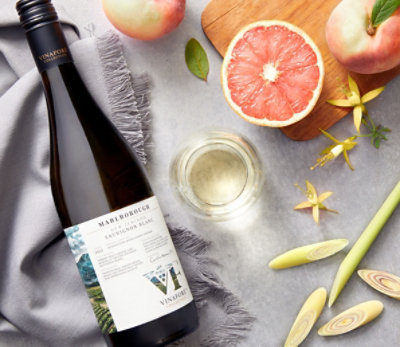
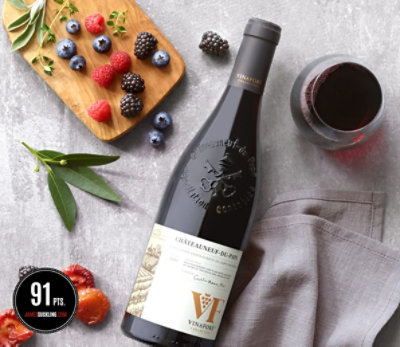
Acclaim
Vintage 2021
91 pts. James Suckling
Varietals - Grenache 80% / Syrah 10% / Mouredre 5% / Cinsault 5%
Rich blackberry and plum notes accented by herbs de provence and aromatic spices.
Châteauneuf-du-Pape is a picturesque wine region nestled in France’s acclaimed Rhône Valley. The region's climate is characterized by hot, dry summers and mild winters with the cooling influence of the Mistral wind providing relief during the growing season and preventing disease. The iconic vineyards of Châteauneuf-du-Pape are covered with smooth round stones called galets. These galets have the ability to retain heat during the day and release it at night, creating a warm microclimate. The abundant sunshine and warm temperatures allow for optimal ripening of Grenache, Syrah and Mourvèdre resulting in wines with intense flavors and aromas. Châteauneuf-du-Pape wines are the perfect representation of the region's terroir, reflecting the unique combination of climate, soil, and geography that make this region one of the most celebrated wine-growing areas in the world.
The 2021 Vinaforé Châteauneuf-du-Pape is sourced from five idyllic villages within the appellation, Châteauneuf, Orange, Couthézon, Sorgues and Bédarrides. It was crafted from a carefully selected blend of traditional Rhône varietals including Grenache (80%), Syrah (10%), Mourvèdre (5%), and Cinsault (5%), all of which combine harmoniously to create a complex and layered palate. To layer complexity while preserving the natural fruit, the wine was aged in a combination of new oak and neutral vessels. The harvest was partially destemmed at 70%, and the fermentation lasted between two and three weeks.
Osso Bucco, Ratatouille, Tangy blue or Roquefort Cheese.